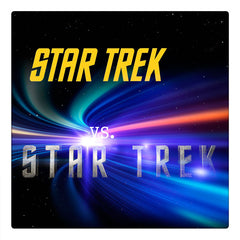Vengeance in the Star Trek Universe

As the Klingons say, “Revenge is a dish best served cold.”
J.J. Abrams’s new Star Trek franchise is cornering the market on revenge. From the first film of the reboot focusing on Nero’s patient wait to avenge his planet Romulus, to the recent re-imaging of Khan’s revenge against the Federation’s abuse and condemnation of his own super-race…for all of the Prime Directive talk in the Star Trek universe, the real struggle is just to rise above “an eye for an eye” justice.The original series was truly about new worlds and new experiences. Creator Gene Roddenberry wanted Star Trek to show audiences how humanity might develop if only it could learn from the lessons of the past – especially ending violence. The Original Series had an anti-war message and depicted the united Federation of Planets as an ideal version of the United Nations, where conflict could be resolved without lingering grudges.
Star Trek: The Next Generation certainly met their share of new civilizations, but at the same time they focused on mediation and negotiating peace. Although Picard and his crew often dealt with the consequences of tough choices, only one episode really dealt with revenge, called The Vengeance Factor. In that episode, Riker has to vaporize someone in order to thwart a murder that would have been committed out of revenge.
Star Trek: Deep Space Nine, with its darker Bajoran/Cardassian post-war themes, had the most potential for stories of revenge. Since the episodes continued story arcs, rather than wrapping up threads each week like the two previous series, the show forced characters to learn that actions have consequences. Still, the show had a greater focus on interpersonal conflicts than other series, and kept revenge to a minimum.
Likewise, crew members on Star Trek: Voyager might have funneled their anger at their situation into vengeance, but never did. In fact, the premise of the show requires the crew of Voyager and the renegade ship responsible for disabling their vessel to join forces in order to make it back home. Additionally, the character Seven of Nine continues the tradition of including members of a hostile group as crew members on the ship.
Star Trek: Enterprise, coming so early in the story, was more about building – new missions, new enemies – that there was no time for revenge.
And in all the original films, just one focuses on a revenge story – but boy is it ever a doozy. In Star Trek II: Wrath of Khan, the villain’s vengeance is the centerpiece of the film, re-animating Kirk’s passion for life and his work, pulling him out of a mid-life crisis and re-connecting him to his youth. It’s probably the film with the most focus on death in the Star Trek franchise, providing a sobering moral for what can happen when you give yourself over to revenge.
And it’s that one story that has influenced so much of the J.J. Abrams reboot films. The two films so far borrow heavily from the plot and characters of Wrath of Khan and the villains from those films are driven to their graves by the need for revenge for the perceived wrongs done to them by the Federation. Their vengeance makes the villains in those films easy to relate to – if someone let my planet implode I’d be pretty ticked off too – and it makes them human, even if technically they might not be.
Borrowing from one of the most successful Star Trek films – the one that critics and fans love the most – has been a smart way to get audiences to buy in to a new Star Trek universe. But let’s hope that Star Trek can bury the hatchet on the vengeance stories and return to the more optimistic futures of a peaceful, and forgiving, humanity first promised back in 1966.